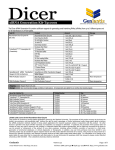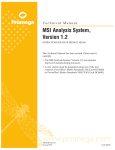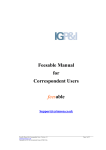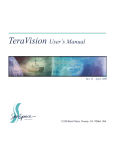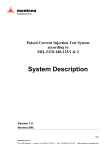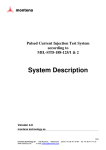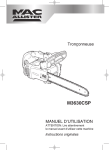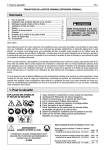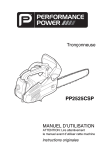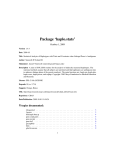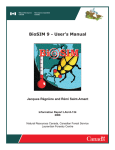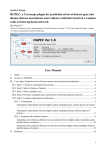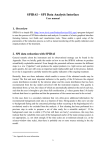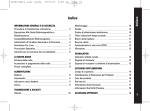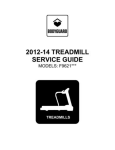Download GeneSetScan (Version 0.02) Scanning gene sets for
Transcript
GeneSetScan (Version 0.02) Scanning gene sets for associations in genome-wide association studies Daniel Schaid and Jason Sinnwell Mayo Clinic Division of Biomedical Statistics and Informatics Rochester MN USA July 2, 2014 1 Contents 1 Introduction 1.1 Description . . . . . . 1.2 Package Contents . . . 1.3 Installation . . . . . . 1.4 System Requirements . . . . . . . . . . . . . . . . . . . . . . . . . . . . . . . . . . . . . . . . . . . . . . . . . . . . . . . . . . . . . . . . . . . . . . . . . . . . . . . . . . . . . . . . . . . . . . . . . . . . . . . . . . . . . . . . . . . . . . . . . . . . . . . . . . . . . . . . . . . . 3 3 3 3 4 2 Reference Files 4 3 SNP Scores 3.1 Definition . . . . . . . . . . . . . . . . . . . . . . . . . . . . . . . . . . . . . . . . . . 3.2 Example Scripts . . . . . . . . . . . . . . . . . . . . . . . . . . . . . . . . . . . . . . 5 5 7 4 Program Options 4.1 Complete List . . . 4.2 Missing Values . . 4.3 Simulations . . . . 4.4 Output Files . . . 4.5 Mapping Distance . . . . . . . . . . . . . . . . . . . . . . . . . . . . . . . . . . . . . . . . . . . . . . . . . . . . . . . . . . . . . . . . . . . . . . . . . . . . . . . . . . . . . . . . . . . . . . . . . . . . . . . . . . . . . . . . . . . . . . . . . . . . . . . . . . . . . . . . . . . . . . . . . . . . . . . . . . . . . . . . . . . . . 7 7 9 9 9 9 5 Parameter Files 5.1 SNP-level . . . . . . . . . . 5.2 Gene-level . . . . . . . . . . 5.3 Gene Ontology . . . . . . . 5.3.1 go-type . . . . . . . 5.3.2 go-gene and go-edges 5.3.3 max-size . . . . . . 5.3.4 gene-set-level . . . . 5.4 KEGG . . . . . . . . . . . . . . . . . . . . . . . . . . . . . . . . . . . . . . . . . . . . . . . . . . . . . . . . . . . . . . . . . . . . . . . . . . . . . . . . . . . . . . . . . . . . . . . . . . . . . . . . . . . . . . . . . . . . . . . . . . . . . . . . . . . . . . . . . . . . . . . . . . . . . . . . . . . . . . . . . . . . . . . . . . . . . . . . . . . . . . . . . . . . . . . . . . . . . . . . . . . . . . . . . . . . . . . . . . . . . . . . . . . . . . . . . . . . . . . . . . . . . . . . . . . . . . . . . . . . . . . . . . . . 9 9 10 10 11 11 11 11 12 . . . . . 13 13 13 13 14 16 . . . . . . . . . . 6 Results 6.1 Log File . . . . . . . . 6.2 HTML and CSV . . . 6.2.1 SNP and Gene 6.2.2 Gene Sets . . . 6.3 Map File . . . . . . . . . . . . . . . . . . . . . . . . . . . . . . . . . . . . . . . . . . . . . . . . . . . . . . . . . . . . . . . . . . . . . . . . . . . . . . . . . . . . . . . . . . . . . . . . . . . . . . . . . . . . . . . . . . . . . . . . . . . . . . . . . . . . . . . . . . . . . . . . . . . . . . . . . . . . . . . . . . . . . . . . . . . . . . . . . . . . . . . . . . . . A SNP to Gene Mapping 16 B Gene Ontology Graph Edges 17 C License 17 2 1 Introduction 1.1 Description The GeneSetScan software offers a general approach to scan genome-wide SNP data for gene-set association analyses. The test statistic for a gene set is based on score statistics for generalized linear models, and takes advantage of the directed acyclic graph structure of the Gene Ontology to create gene-sets. The method can use other gene-set structures, such as the Kyoto Encyclopedia of Genes and Genomes (KEGG), or even user-defined sets. Our approach combines SNPs into genes, and genes into gene-sets, but assures that positive and negative effects on a trait do not cancel. To control for multiple testing of many gene-sets, we use an efficient computational strategy that accounts for linkage disequilibrium and correlations among genes and gene sets, and provides accurate step-down adjusted p-values for each gene-set. 1.2 Package Contents The package contains the pre-compiled executable and reference data files to define gene sets. The most important step for the user is to create a file of SNP scores, and we provide scripts and documentation to guide you through that process. The package has the following directory structure, with a brief description of the sub-directories in italics: • INSTALL.txt • README • bin/ binary executable • refdata/ reference files for mapping SNPs to gene sets, described in section 2 • doc/ license and manual • example/ Example parameter files and example script to run the program • SNPScores/ scripts to create SNP scores, described in section 3 1.3 Installation We provide the pre-compiled GeneSetScan executable compiled for 64-bit Linux CentOS 4.3, which should work on most 64-bit Linux distributions. We can compile for other systems upon request. Make sure these steps are taken before running the program. 1. Copy the binary executable from GSS/bin/ to a location where it can be found by your shell commands. You could use the full path to GSS/bin/GeneSetScan to call the program, or copy it to a globally-available bin directory on your system. 2. Uncompress all reference files and place in GSS/data. The reference files were compressed using gzip on Linux. Use either gunzip or another de-compression program. The parameter files will tell the program where to find these files. 3 1.4 System Requirements Memory and disk space usage are two issues to consider before running this program. First, we define ”memory” as system memory needed while the program is running from start to finish, and we define ”disk space” as the hard-disk space needed to store any file on your system. We have tested GeneSetScan on various datasets that each were genotyped on 550K SNP chips, ranging from 1000 to 2500 subjects. The disk space needed for the complete SNP score file (see section 3) in those studies can exceed 10GB, and the memory needed to run the program can exceed 12GB. Because the machine language commands for programs compiled on 32-bit machines cannot index more than 4GB of memory, GeneSetScan should only be run on 64-bit machines with sufficient memory available during run-time. Table 1 contains a summary of the approximate disk and memory usage on analyses we have run. Nsubj 1000 2500 NSN P 550K 550K Disk 8GB 13GB Memory 4GB 14GB Table 1: Approximate Disk and Memory Usage We estimate that the program will run with a reasonable amount of memory and consume moderate disk space for SNP chips up to 1 million SNPs. It will require more resource management to run this method on chips or imputed genotype sets that provide more coverage than 1 million SNPs, so we currently do not recommend using such large SNP sets. Run-time is dictated by the number of simulations, with only a small portion attributable to other tasks. Run-time for 1000 simulations is about 1 hour, and there is a linear increase in time for more simulations with no additional memory cost. 2 Reference Files We provide all files necessary for GeneSetScan to map SNPs by rsid to gene sets. We provide the following set of mapping reference files: • edges.csv file defining the GO directed acyclic graph edges (release date: March 2011) • gene2go.human list of genes mapping to GO terms (release date: March 2011) • hsa pathway.list list of genes mapping to KEGG human pathways (release date: March 2011) • gene snp.B37.coding.dat maps SNPs to genes using rsids of SNPs from HapMap reference panel updated to NCBI Build 37 positions, mapped to Build 37 gene start/stop position (HapMap-23a and Build GRCh37p2) More details on how we created the above mapping files can be found in Appendices A and B. 4 3 SNP Scores 3.1 Definition The GeneSetScan program requires an input SNP score file. This file contains the contirubtion of each subject and each SNP to the score statistic that tests associations of SNPs with a trait. The rows are for SNPs and the columns are for subjects. The first column is the SNP rsid, followed by the columns that are the scores per subject per SNP from a model fit, Si,j = (Yi,j − Yˆ.,j )∗(Gi,j − G¯i,. ), where • Yˆ.,j is the fitted value for the subject j from a logistic model that may or may not include adjusting covariates • Gi,j is the SNP dosage at SNP i for subject j, typically the minor allele count • G¯i,. is the mean SNP dosage over all subjects The general format for the SNP score file is as follows: rsid score1 score2 score3 score4 ... Where an example looks like this: rs100 0.152 -0.330 0.104 -0.225 ... rs105 -999.0 0.951 -0.312 0.152 ... rs222 0.443 0.051 -0.875 -0.342 ... ... Missing values need to be numeric, yet different from the observed scores such that we can tell GeneSetScan to treat them as missings; setting missing values to -999.0 will work most of the time. We provide a schema of the scripts we provide to create the SNP-Scores in figure 1, and the scripts themselves are described below. 5 Figure 1: SNP-Score schema 6 3.2 Example Scripts Users are free to use any program to create the SNP score file, but we provide some general scripts for computing SNP scores by chromosome using R[5], PLINK [6], and some shell scripting. The scripts we provide are set up to run a logistic regression in R for a binary case-control status. • unadjustedScores.R an R script to compute SNP scores for a single chromosome, not adjusted for covariates. The script assumes that plink can be called via a system command. • adjustedScores.R an R script to compute SNP scores for a single chromosome, adjusted for covariates. The script assumes that plink can be called via a system command, and requires some editing for the number of covariates to adjust for in the model. • startScores.sh An example shell script that creates the SNP scores in separate R batch jobs for each chromosome. • catScores.sh An example shell script that concatenates the SNP scores for each chromosome into one large SNP-score file. The individual chromosome SNP score files are large and can be re-created within a few hours, so we recommend deleting them once the large score file is created. 4 Program Options 4.1 Complete List Program options can be viewed with the program help menu, invoked like this: > GeneSetScan -h OR > GeneSetScan --help Each option has either a short name preceded by one dash (“-”), or a long name preceded by two dashes, followed by a space and the program option (except flags like --version/-v and --help/-h). Below is the complete list of options, listed with the default and brief description. Usage: -short, --long options with default values brief description -h, --help display the help menu -ge goEdges.dat, --go-edges goEdges.dat file of GO edges -gs geneSNP.dat, --gene-snp geneSNP.dat file of gene-snp mapping 7 -gg goGene.dat, --go-gene goGene.dat file of go-gene mapping -kg keggGene.dat, --kegg-gene keggGene.dat file of kegg-gene mapping -sc score.dat, --score score.dat file of scores -r zero, --replace zero replace missing scores(mean, zero) -mv -999, --missval -999 missing value code for scores -m GO, --method GO method (GENE, GO, KEGG, SNP) -gl sqrtmean, --gene-level sqrtmean gene-level scoring (max, mean, sqrtmean). Caution: max, mean are experimental -gm nor, --gene-moments nor gene-level moments (nor, sim). Caution: sim is experimental -gsl wtdmean, --gene-set-level wtdmean gene-set-level scoring (maxZ, meanZ, wtdmean). Caution: maxZ, meanZ are experimental -gt all, --go-type all type of GO DAG (all, biological_process, cellular_component, molecular_function) -d 50000, --dist 50000 max absolute dist from SNP to gene start/stop, in bp distance -ms 30, --max-size 30 maximum no. genes in a set. Caution: Compute time increases with max-size -ns 1000, --nsim 1000 number of simualtions -s -9, --seed -9 integer for random number seed (set by clock if <= 0 or not specified) -html output.html, --html-output output.html ouput file in html format -csv output.csv, --csv-output output.csv ouput file in csv format -mw, --map-write turn on writing of map output -mf output.map, --map-output output.map output map file name -par <file name here>, --parfile <file name here> file of options, one per line. -v, --version 0.01 All program options can be called on either the command line or a parameter file. The large number 8 of required options are managed easiest with a parameter file that is then input to GeneSetScan. 4.2 Missing Values The --missval option tells GeneSetScan how to find missing input scores, and --replace tells it how to replace the missing value, namely, with zero or the mean score at that SNP. 4.3 Simulations The --nsim option tells GeneSetScan how many simulations to perform, and --seed tells it the seed to start with so that simulations can be reproduced in separate runs. 4.4 Output Files Output files are automatically written to default file names by the base name “output”, and the appropriate suffix. We recommend using --html-output and --csv-output to specify your own file names for the html and csv output files. A third output “mapping” file is optional and only applies to gene-set-level analyses. The --map-write option flag tells GeneSetScan to write the optional map file with information on how SNPs and genes map to gene-sets within the analysis. The --mapoutput option tells GeneSetScan the name you want for it. More details on the output files can be found in section 6. 4.5 Mapping Distance The --dist option specifies how far outside the gene start/stop positions to allow SNPs to map to genes. The default setting is 50,000 base pairs, and GeneSetScan will allow --dist to be any number between 0 and 50,000 because the reference file that comes with the package was created with a maximum of 50,000 base pairs. If you need a larger range than 50,000 base pairs, we can create a different reference file upon request. More information on the SNPs mapping to genes can be found in Appendix A 5 Parameter Files We discuss example parameter files in ascending order of set size: SNP, Gene, GO-Namespace, GO-All, and KEGG, which are given as they appear in the GSS/example directory. We highlight the arguments that are needed as the sets get more complex. As described in section 4, the program options have a long and short name. All our examples show the long name, which are preceded by two dashes(-), followed by any number of white spaces, then the option setting. The options in all parameter files can be in any order, so we place the ones that change the least at the top, allowing us to focus on the ones that vary at the bottom. 5.1 SNP-level SNP-based tests are commonly available in other programs, but we make it available because it is convenient to have a complete set of SNP, Gene, and Gene-Set association tests avaialable in one program. Furthermore, the adjusted p-values are an advantage over other programs. 9 We see in the list below the first four options control the missing values and the simulations, which should not change much unless you want a different seed or more precise p-values. The score file is also required and will be used for all analyses on the same dataset. Next, we specify the names of the html and csv files specific to the analysis type so we can keep results separate when running multiple analyes. Finally, the option for method is set to SNP to tell GeneSetScan to run the SNP tests. −−replace zero −−missval -999.0 −−nsim 1000 −−seed 12887321 −−score ../SNPScores/SNPScore.txt −−html-output ./results/snp.html −−csv-output ./results/snp.csv −−method SNP 5.2 Gene-level For gene-level tests, we change method to GENE, change the names of the output files, and add three more options. The first option added for gene-level analysis is --gene-snp, which tells GeneSetScan where to find the SNP to gene mapping file in refdata. The other added options tell the program how to score each gene. For the logistic model scoring of each gene, we set the --gene-level option to sqrtmean for the square-root of the mean of the SNP scores combined over a gene, for which we estimate the moments for the gene scores assuming a multivariate normal distribution, specified by --gene-moments nor. −−replace zero −−missval -999.0 −−nsim 1000 −−seed 12887321 −−score ../SNPScores/SNPScore.txt −−html-output ./results/gene.html −−csv-output ./results/gene.csv −−method GENE −−gene-snp ../refdata/gene snp.dat −−gene-level sqrtmean −−gene-moments nor 5.3 Gene Ontology For the Gene Ontology gene sets we keep most of the options from the gene analysis setting with updates to output file names. We need to change --method to GO and specify which GO namespace to use. Then we add options to specify names of two more reference files, give GeneSetScan a maximum set size for gene sets, and finally, give instructions on scoring genes for gene sets. We describe these options below. 10 5.3.1 go-type The --go-type option tells which of the three Gene Ontology namespaces to use: Biological Process, Molecular Function, and Cellular Component. Table 2 gives the GO Namespaces and their --go-type string that is recognized in the program, which includes ALL for terms from all three namespaces. Namespace Biological Process Molecular Function Cellular Component ALL --go-type biological-process molecular-function cellular-component all Table 2: GO Namespaces --go-type names 5.3.2 go-gene and go-edges In addition to the Gene-SNP file needed in the gene analysis above, we have to tell GeneSetScan where to find two GO-specific data files that we provide in refdata. The first is the --go-gene file that links Entrez Gene IDs to GO terms, which we created by subsetting to only those entries for the human species. The second GO-specific data file is the --go-edges file, which we pre-processed to define the GO nodes and edges that connect them. More information on the GO structure can be found in Appendix B. 5.3.3 max-size Each namespace is a directed acyclic graph with the lowest level terms being the most specific and higher-level terms more general. At the higher levels the number of genes per set grows such that the tests combine information over so many genes that it it is unlikely to have a meaningful result. Additionally, there is a computational cost for larger gene sets. For these reasons, the user can limit analyses to sets with no more than the number of genes specified by max-size. For all of the Gene Ontology gene sets, we recommend a --max-size of 100. 5.3.4 gene-set-level We carry forward the gene-level scoring from the gene analysis, but we additionally need to tell GeneSetScan how to score genes within the gene sets. We have implemented the weighted mean, given by --gene-set-level wtdmean, of the gene-specific scores, where the weights are the inverse of the variance of the gene score. [[DAN PLEASE HELP CORRECT]]. −−replace zero −−missval -999.0 −−nsim 1000 −−seed 12887321 −−score ../SNPScores/SNPScore.txt −−html-output ./results/go.bp.html 11 −−csv-output ./results/go.bp.csv −−gene-snp ../refdata/gene snp.dat −−go-gene ../refdata/gene2go.human −−go-edges ../refdata/edges.csv −−method GO −−go-type biological-process −−max-size 100 −−gene-level sqrtmean −−gene-moments nor −−gene-set-level wtdmean Tio run analyses for the other GO namespaces, just change the --go-type option to one of the items listed in Table 2 5.4 KEGG For analysis of gene sets defined by the Kyoto Encyclopedia of Genes and Genomes [3], we maintain most of the same options as described above with updates to the output file names to reflect the analysis method. The method option is changed to KEGG, and we only need to specify one file for the genes mapping to KEGG pathways by the --kegg-gene option for the refdata file called hsa pathway.list We change --max-size to 5000 because some KEGG sets are large. However, there are fewer KEGG gene sets overall, so we are able to capture all of them without too much computational cost. Last, we use the same gene-level and gene-set-level scoring as above. −−replace zero −−missval -999.0 −−nsim 1000 −−max-size 5000 −−seed 12887321 −−score ../SNPScores/SNPScore.txt −−html-output ./results/kegg.html −−csv-output ./results/kegg.csv −−method KEGG −−kegg-gene ../refdata/hsa pathway.list −−gene-snp ../refdata/gene snp.dat −−max-size 5000 −−gene-level sqrtmean −−gene-moments nor −−gene-set-level wtdmean 12 Figure 2: Gene Output 6 Results 6.1 Log File All calls to the program generate the log information to the screen, which can be directed to a file with >, which we recommend because the log information is verbose and provides useful summaries of the number of SNPs, genes, and gene-sets that are used. > GeneSetScan --par gene.par > results/gene.out 6.2 HTML and CSV The GeneSetScan program writes the primary results to both a comma-separated and html file. The format of these files varies by the analysis method. As you will see, it is much more convenient to view and use the html file, but we also provide the csv files in standard formats so they can be parsed by other tools. 6.2.1 SNP and Gene The SNP and Gene results are similar, in that there is only one line of output per test, so the csv file looks like the following frame, and the html file looks like Figure 2. geneID, num_snps, 200, 61, 201, 22, 202, 29, 300, 43, score, 2.39, 2.63, 2.21, 0.503, mean, 0.964, 0.943, 0.969, 0.982, sd, zscore, 0.267, 5.36, 0.337, 5.02, 0.248, 5.01, 0.188, -2.55, 13 mn_snp_rank, 7.28e+04, 4.85e+04, 9.38e+04, 2.88e+05, pval 0.342 0.626 0.627 0.999 6.2.2 Gene Sets The output files for gene set results provide more information and thus have a more complex format. Because each gene set can have multiple set ids and multiple genes mapping to them, we provide all of the information in 3 columns of the csv file. The first column is the setID, which serves as an index to identify the lines for each set, starting at 1 with the set with the lowest p-value. The second column, variable is a text field saying what information is provided in the last column, labeled value. Figure 3 shows the html file with similar information, but condensed to a table with a row for each gene set, and active links to both the genes and gene sets. setID, variable, value 1, num_genes, 3 1, score , 1.472 1, mean , 0.9367 1, sd , 0.1455 1, zscore , 3.68 1, mn_gene_rank , 7560 1, pval , 0.856 1, geneID, 101 1, geneID, 102 1, geneID, 103 1, GOID, GO:0010001 1, GOID, GO:0010002 2, num_genes, 4 2, score , 1.229 2, mean , 0.9509 2, sd , 0.08108 2, zscore , 3.432 2, mn_gene_rank , 7560 2, pval , 0.978 2, geneID, 1001 2, geneID, 1002 2, geneID, 1003 2, geneID, 1004 2, GOID, GO:00100003 14 Figure 3: GO:Biological Process Output 15 6.3 Map File An optional output file is a map file, which is only available for gene set analyses. The example below shows how the setID is the same as the setID in the csv file, and it gives which SNPs are mapped to the genes that go into the gene sets. setID, gene, snp 1, 101, rs100001 1, 101, rs100002 1, 101, rs100003 1, 101, rs100004 1, 101, rs100005 1, 102, rs20001 1, 102, rs20002 1, 102, rs20003 1, 103, rs3001 1, 103, rs3002 1, 103, rs3003 2, 1001, rs4000001 2, 1001, rs4000002 2 1001, rs4000003 ... Appendix A SNP to Gene Mapping SNPs that are part of HapMap release 23a mapped to genes by the NCBI human genome build 37 positions. To create this file, we used a map file for HapMap panel available from Plink here: http://pngu.mgh.harvard.edu/~purcell/plink/res.shtml#hapmap, which we updated the SNP positions to NCBI human genome build 37.1 and mapped them to genes if they were within +/-50kb of the start/stop of any protein-coding gene. The gene start/stop positions are provided by seq gene.md from this site: ftp://ftp.ncbi.nih.gov/genomes/MapView/Homo_sapiens/sequence/BUILD.37.2/initial_release/seq_gen where we use only the start/stop positions of non-pseudo genes for the Genome Reference Consortium (GRCh37.p2-Primary Assembly). The protein-coding status of genes is provided in Homo sapiens.gene info, from this site: ftp://ftp.ncbi.nih.gov/gene/DATA/GENE_INFO/Mammalia/Homoe_sapiens.gene_info 16 phone: 507-284-0639 fax: 507-284-9542 email: [email protected] References [1] Schaid DJ, Sinnwell JP, Jenkins GD, McDonnell SK, Ingle JN, Kubo M, Goss PE, Costantino JP, Wickerham DL, Weinshilboum RM. Using the gene ontology to scan multilevel gene sets for associations in genome wide association studies. Genet Epidemiol 2011 Dec 7 [2] The Gene Ontology <http://www.geneontology.org> [3] KEGG: Kyoto Encyclopedia of Genes and Genomes <http://www.genom.jp/kegg> [4] Lin DY. 2005. An Efficient Monte Carlo approach to assessing statistical significance in genomic studies. Bioinformatics, 21:781-787. [5] The R Project <http://www.r-project.org> [6] Purcell, Shaun. Plink (version 1.07). <http://pngu.mgh.harvard.edu/purcell/plink/> 18

















